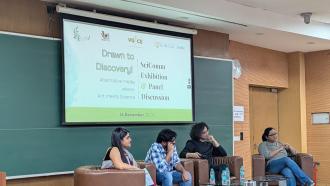![Noctiluca blooms in the Arabian Sea, as seen from space. [Image Credits: Norman Kuring/NASA] Snow meltdown in the Himalayas is causing sparkling algal blooms in the Arabian Sea](/sites/researchmatters/files/styles/large_800w_scale/public/snow_meltdown1_result.jpg?itok=gA8exm23)
Noctiluca blooms in the Arabian Sea, as seen from space. [Image Credits: Norman Kuring/NASA]
In August 2019, some waters along the beaches of Chennai witnessed the colourful displays of planktonic blooms of Noctiluca, which glowed a beautiful neon blue in the dark. Mesmerised by the bioluminescence of these tiny creatures, people shared photos and videos as the waves, filled with colours, danced. But, blooms of the sea sparkle (Noctiluca scintillans) are no reason for joy, as they are a stark indicator of how climate change is affecting our oceans. Yes, in recent years, Noctiluca has replaced the most common phytoplankton, known as diatoms in the seas, leading to a drop in oxygen levels in the waters. Interestingly, a recent study suggests that this phenomenon may be connected to the melting snow of the lofty Himalayas due to global warming.
The study, led by researchers from Columbia University, USA, and published in the journal Scientific Reports, shows that the loss of snow cover in the Himalayan-Tibetan plateau is leading to warmer and more moist winds emanating from the mountains. These winds, in turn, warm the northern Arabia Sea surface waters, divide the water into layers with different temperatures and prevent the circulation of nutrients from deeper waters. This situation is turning favourable to only one algal species, the Noctiluca scintillans, at the cost of all others.
“Noctiluca blooms in Indian waters have been increasing since almost a decade,” says Ms Mahi Mankeshwar. She is a marine researcher interested in understanding trophic changes in the Arabian sea and was not a part of the study. “It is only because of more visual incidents, like fish die-offs or bioluminescence, that we are beginning to notice the consequences of a fast-changing climate”, she adds.
Phytoplanktons are mostly microscopic, single-celled organisms that live suspended in water. They take up carbon dioxide and make their food using the sun’s energy, just like plants do on land. Hence they are at the bottom of the food chain as energy producers, supplying food to the rest of the marine life—from small fish to giant predators like the sharks, none of which can produce their own food.
However, some phytoplankton, like Noctiluca, not only make their own food but also kill and eat other plankton, small eggs, and nutritious particles around them. Thus, they can survive in stratified and nutrient-deficient waters. The warm, nutrient-depleted layer of water sits on the surface of the ocean while the cooler, nutrient-rich, waters go to the deep. Thus the upper layers do not get the much-required nutrients, like nitrogen and phosphate, for the phytoplankton to grow. But this environment is perfect for Noctiluca, which can feed on other planktons and survive in nitrogen-deficient waters.
“These exceptional changes appear to be creating a niche particularly favourable to the mixotroph, Noctiluca scintillans, which has recently replaced diatoms as the dominant winter bloom-forming organism,” say the researchers of the study.
The decreasing snow-cover in the Himalayan-Tibetan Plateau, due to the warming climate, has warmed the usually cold north-easterly winds, which blow into the Arabian Sea in winter, and reduced its intensity. The study found a direct correlation between the loss of snow cover in the Himalayas and the decline of inorganic nitrates in the Arabian Sea since 1960. “Over the past four decades, the Arabian Sea has experienced a profound loss of inorganic nitrate. In all probability, this is due to increased denitrification caused by the expansion of the permanent oxygen minimum zone,” say the researchers.
The blooms of doom
On a global level, the increasing Noctiluca blooms show how food-producing marine organisms respond to physical and biochemical changes in the seawater, brought about by a warming climate. Images of climate change are no more restricted to melting glaciers and receding ice-lines. “I think it is time that those images are also accompanied by something much closer to home and more tropical, like these planktons that glow in the dark,” adds Ms Mankeshwar.
With the low oxygen conditions steadily becoming a permanent feature of the Arabian Sea, other species that do better in such environments will increase. Jellyfish, which occur seasonally in Indian waters, are now more frequent with increasing Noctiluca blooms. Although these blooms are non-toxic, their spread can perturb the delicate oceanic ecosystem. Being planktonic foragers, they feed on larvae of commercially valuable fish such as sardines and anchovies.

A Noctiluca bloom in the Malvan shore of Sindhudurg district [Image credits: Mahi Mankeshwar]
In the Arabian Sea, these blooms have started to affect the livelihoods of small-scale fishers. Shore-seiners and the gill-netters end up with a bulk by-catch of jellyfish, which has no market value.
“Although our investigations in Indian waters are still in their nascency, we anticipate that, in the long run, these blooms could lead to a reduction in catch of some of these commercially important species,” says Ms Mankeshwar.
However, there is also a brighter side to this scenario. Reduction in oxygen levels increases fish mortality and results in mass fish die-offs. These events offer a short term economic benefit to the local fishermen as they end up getting bumper catches during such die-offs.
The study shows that we are past the warning bells on climate change, and now, the ripple effects have begun to affect a wide variety of organisms in our oceans. However, for us to understand this interplay completely, we need more data like that gathered from the study.
“Data on bioluminescent blooms along Indian shorelines, which is currently inadequate, is essential to establish their seasonal trends. Streamlined documentation of these occurrences through citizen science would be beneficial in monitoring the path of these blooms,” urges Ms Mankeshwar.






